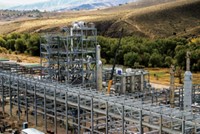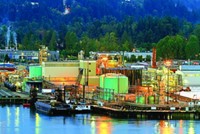Advertisement
Grab your lab coat. Let's get started
Welcome!
Welcome!
Create an account below to get 6 C&EN articles per month, receive newsletters and more - all free.
It seems this is your first time logging in online. Please enter the following information to continue.
As an ACS member you automatically get access to this site. All we need is few more details to create your reading experience.
Not you? Sign in with a different account.
Not you? Sign in with a different account.
ERROR 1
ERROR 1
ERROR 2
ERROR 2
ERROR 2
ERROR 2
ERROR 2
Password and Confirm password must match.
If you have an ACS member number, please enter it here so we can link this account to your membership. (optional)
ERROR 2
ACS values your privacy. By submitting your information, you are gaining access to C&EN and subscribing to our weekly newsletter. We use the information you provide to make your reading experience better, and we will never sell your data to third party members.
Business
A Solvent Dries Up
Acetonitrile is in short supply, and chemists are concerned
by Alexander H. Tullo
November 24, 2008
| A version of this story appeared in
Volume 86, Issue 47

A SHORTAGE of acetonitrile is leaving chemists around the U.S. and beyond wondering how long their supplies will last and what their options will be if stocks run dry.
There are good reasons why the situation is making chemists feel vulnerable. Thousands of them use the polar solvent in high-performance liquid chromatography. It is also used in pharmaceutical synthesis and in the extraction of butadiene from streams of C4 hydrocarbons.
Laboratory chemical suppliers have been allocating acetonitrile to existing customers or not selling it at all. "The market is beyond short," says Jerry Richard of Purification Technologies, a Chester, Conn.-based firm that buys acetonitrile in bulk, purifies it, and sells it to laboratory chemical suppliers. "You have people scrambling around trying to get material. My phone is ringing off the hook."
Richard says the heart of the problem is that acetonitrile goes into applications that are healthy and growing. But its production is tied to another chemical, acrylonitrile, which is in decline.
Acetonitrile is a coproduct of the process used to make acrylonitrile, a building block for acrylic fibers and acrylonitrile-butadiene-styrene (ABS) resins. An acrylonitrile plant yields 2 to 4 L of acetonitrile for every 100 L of acrylonitrile produced. Only one U.S. producer, Ineos, bothers to extract it for sale to the merchant market, which it does at plants in Green Lake, Texas, and Lima, Ohio. Most acrylonitrile producers incinerate the coproduct as fuel.
And it is acetonitrile's status as a minor coproduct that has led to its present scarcity. Amin Dhalla, business director for Ineos Nitriles, says acrylonitrile production has been ebbing. Demand for ABS resins, used in cars, electronic housings, and small appliances, is slumping around the world because of the global economic slowdown. The acrylic fiber market is also on the decline, losing market share to polyester fibers. Operating rates at acrylonitrile plants are less than 60% globally.
COMPOUNDING the problem, Ineos has suffered from production outages over the past year. For example, its Green Lake plant was shut down in September in preparation for Hurricane Ike. Its Lima plant was down during the summer because of a lightning strike. Dhalla says the Texas plant will have more downtime early next year when the company brings a 20% expansion of its acrylonitrile capacity onstream.
According to Dhalla, Ineos is having discussions with customers regarding what it can supply. "Obviously, we want to run our plants, but the economics of supply and demand will determine what happens to acrylonitrile, and that will determine what happens to acetonitrile," he says.
John Radke, director of research essentials at lab chemical supplier Sigma-Aldrich, thinks the shortage will last through the second quarter of next year. He says his company prepared for the shortage by building up inventories and should be able to supply contract customers.
For Sigma-Aldrich and some other lab chemical suppliers, new customers are a different story. Radke says Aldrich is looking for acetonitrile supplies like anyone else is, and is paying six to eight times more than it did just in August. "New customers not under contract with Sigma-Aldrich will pay the fair market catalog list price," he says.
Chemists contacted by C&EN aren't panicking yet. Bruce S. Levison, a staffer with the Cleveland Clinic, uses about 1 L of acetonitrile per day for HPLC. He has about 20 L on hand and is awaiting word on an order he submitted with his lab chemical supplier for more. "I am not screaming that I can't do my work," he says.
David R. Liu, a chemistry professor at Harvard University, says his lab group planned ahead by stocking up. "I'm aware of the problem, but so far it hasn't had a major impact," he says. "If we go two months without being able to get any—that might be a problem."
If the acetonitrile shortage doesn't abate by early next year, chemists could adapt to alternative solvents like tetrahydrofuran or methanol. But Liu says for some applications, no solvent works quite like acetonitrile. "Unfortunately, substitution is not a viable option for some automated syntheses that are optimized to work in acetonitrile," he says.




Join the conversation
Contact the reporter
Submit a Letter to the Editor for publication
Engage with us on Twitter